Dee Estuary Birding
Monthly Newsletter...
October 2020 Newsletter

The Status of Rock Pipits (Anthus petrosus)
at Hilbre and in the Dee Estuary
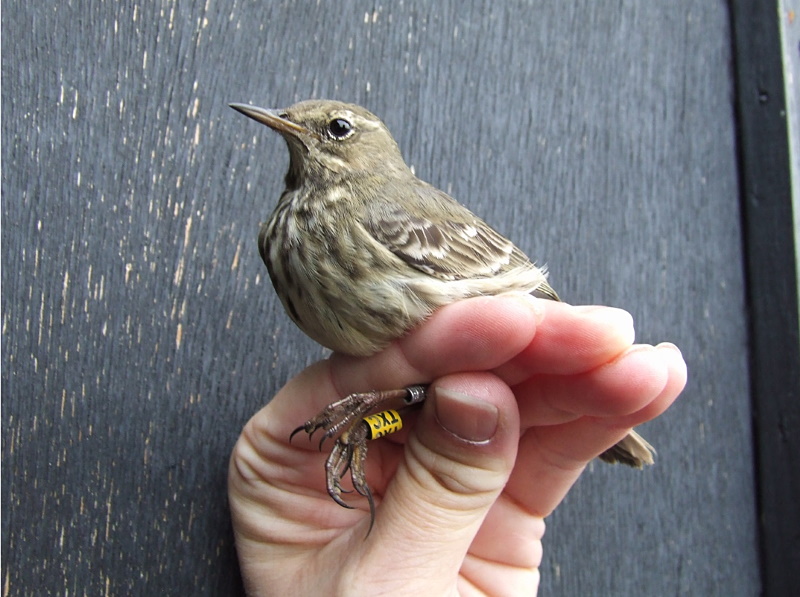
© Hilbre Bird Observatory
Introduction
David Norman, in the 2008 CAWOS atlas Birds in
Cheshire and Wirral, pointed out the lack of verified information about
Rock Pipits in Wirral and raised a number of interesting questions for
Wirral bird watchers and ringers to answer. He pointed out that very
little information regarding the race of birds found on Wirral was
available. There are known differences in diet between races of rock
pipits which he outlined and he noted that although the bulk of the
records are from the winter, the autumn and spring migration periods
there were some records indicating that birds had been present in the
summer.
This note gives some more background and documents the ringing of rock
pipits undertaken by the Hilbre Bird Observatory in the past 20 years.
This ringing data provides concrete evidence, albeit in relatively
small quantities, that supports the idea that British race rock pipits
(Anthus petrosus petrosus)
sometimes spend the winter around Hilbre and
breed on the island and that Scandinavian race rock pipits (Anthus
petrosus littoralis) visit Hilbre but probably spend the winter
in the
Dee salt marshes.
History
Coward and Oldham, in their book Birds of Cheshire
published in 1900, say that most of the Wirral coast is unsuitable for
breeding Rock Pipits but they are to be found breeding on Hilbre. They
mention a visit they made in May 1894 when they saw several pairs of
breeding rock pipits themselves. They mention Brockholes who had seen
Rock Pipit eggs from Hilbre and Mr A O Walker had found three nests
there in 1858. This was a time before ornithologists accepted there
were races of birds and Rock Pipit and Water Pipit had not been split.
They only write about breeding birds and made no comment about
migration or wintering.
Eric Hardy, in his book Birds of the Liverpool Area published in 1941,
mentions that Rock Pipits are birds of passage at Hilbre but noted that
he found a pair breeding on the island in May 1940.
J D Craggs, in his book Hilbre, The Cheshire Island published in 1982,
notes that Rock Pipits have been seen on Hilbre in every month except
June and July and highlights the Autumn passage as a regular
phenomenon. He notes that there are records of Rock Pipits breeding but
classifies them as old and not well documented.
So there are eye witness accounts from the mid-19th century up to 1940
of breeding Rock Pipits on Hilbre and accounts of Spring and Autumn
passage from the 1930s to the 1980s. Norman mentions a breeding record
in 2007 and notes another possible breeding record from 2005.
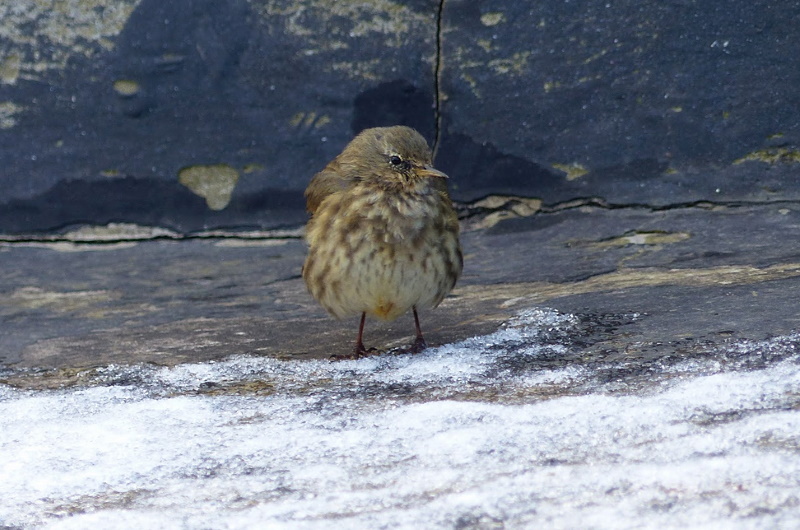
The 21st Century
There have been 73 ringing encounters with rock
pipits on Hilbre in the period 2002 to 2016 that involved 28 different
birds. One bird was identified as breeding on the island in 2015 and
2016, 2637605 a male. Two
birds were identified as breeding on the island in 2016, 2637605 for a second year and 2637609
a new female. Four young were ringed on the island at dates when they
could be identified as the outcome of breeding success. Two birds were
found to have spent the winters around the island but had not been
recaptured during the breeding season. Thus the 28 ringed birds
represent: two wintering birds; two birds that had been part of the
breeding population; four young, the results of breeding; and the other
20 birds were classified as passage birds. One of the passage birds had
a colour ring, yellow TXC, which was attached to the bird in the summer
of 2016 on the island of Giske, an island off the west coast of Norway.
Analysis of 21st Century Data
Two Rock Pipits, 2637605
and 2637609,
were re-trapped during the breeding seasons of 2015 and 2016 on Hilbre.
It was possible to identify the first as a male from his cloacal
protuberance and the second as a female because she was developing her
brood patch. More important than this though was that both birds could
be identified as the British race because they were both dark and did
not have a trace of a pink flush, reduced streaking or white features
that would be expected with Scandinavian birds. So we were able to
reason that the birds breeding on Hilbre were the British race, this
was the first evidence identifying petrosus
as the race of rock pipits breeding on Hilbre. This was not a surprise
but the corollary to this, because one of the breeding birds spent the
winter of 2015 on the island, was that we could also assert that
British race birds spend the winter on Hilbre as 2637605 had done just this.
In October 2016 TXC, the Norwegian bird, was recaptured twice before it
disappeared. We were lucky enough to catch one of the juvenile birds
that had been ringed on Hilbre in 2016 while we had TXC in the hand.
TXC had been ringed as a juvenile in 2016 in Norway. We were able to
compare both birds and to confirm what was expected that the birds
could not be identified to race from plumage features at that time of
year. However the Norwegian rings identified the bird as a Scandinavian
race bird (littoralis). The
consequence of this was that we had the first piece of ringing evidence
that Scandinavian birds pass through Hilbre in the autumn.
When we look at the 29 new birds that have been captured on Hilbre we
see that two birds spent the whole winter on the island, two birds bred
on the island and four of the other birds were young produced on the
island. This leaves 21 birds that we have classified as passage birds.
TXC, the Scandinavian bird was placed in this category as it only spent
a week on the island in the autumn of 2016.
The area of the Hilbre island group is about 4.4 hectares, a small area
when considering the available breeding locations for rock pipits. The
island group is the only rocky area that is not covered by the tide in
the Dee estuary. This being the case it is the only area suitable for
rock pipit to breed. The consequence of these issues is that Hilbre
clearly has supported and does support breeding rock pipits of the
British race but the area where they can breed is small and limits the
number of birds able to use the island to breed.
In the winter the available feeding areas are larger as British race
Rock Pipits can use the intertidal areas that are uncovered at low tide
and the Scandinavian birds that we know come to the island prefer to
feed in the salt marsh environment of the Dee, a much larger area. The
fact that TXC only stayed round the island for a week before moving is
a small piece of evidence confirming that Scandinavian birds pass
through Hilbre rather than remain round the island for much time. The
Rock Pipits that have been trapped on Hilbre since 2002 have been
passage birds and most of them have been first year birds so it would
seem reasonable to suggest that a high proportion are Scandinavian
birds that are about to winter in the Dee salt marshes rather than
British race birds that would be expected to stay around Hilbre to take
advantage of the considerably smaller intertidal areas to feed.
Moving forward in time to March 2020, the day before the COVID19
lockdown started, a Rock Pipit was caught on Hilbre. This bird was
paler looking than a British race bird would be expected to look, it
had a pale supercilium, it had a greyish tinge to its head and tail
(the central tail feathers were still growing indicating that it was
near the end of its prebreeding moult), it had very little streaking on
its belly and flanks and it had a very faint pinky/buff tinge on some
of its breast feathers. It had a relatively short wing length, 85mm, so
there was a relatively high chance of it being female. All of these
features lead to the bird being classified as a Scandinavian race bird, littoralis.
This was the first bird ever caught on Hilbre that could be attributed
to the Scandinavian race on plumage features and the first Scandinavian
race bird ringed in the spring.
Summary
Rock Pipits breeding and wintering around Hilbre
since 2002 have provided evidence for the following: 1. The British
race (petrosus)
breeds on Hilbre from time to time; 2. The British race also spends
some winters in the vicinity of Hilbre; 3. The Scandinavian race (littoralis)
is a passage bird in autumn but does not spend much time on Hilbre
during its journey to suitable feeding sites. It would appear that the
speculation regarding Scandinavian race rock pipits wintering in the
Dee salt marshes is probably true. The Scandinavian bird caught and
ringed in March 2020 suggests a return passage of Scandinavian birds
and may have been a wintering bird from the Dee salt marshes.
Post Script
In the Cheshire Atlas David Norman noted the feeding
preferences of both races of rock pipits. We are able to add the
following observation of feeding behaviour from our current
investigation.
During the summer of 2015 a Rock Pipit was seen to kill and eat a
common sea slater (Ligia oceanica)
an inhabitant of the rocky cliffs of the island and known to the Hilbre
regulars as jaspers. This insect is the largest of the UK’s wood lice,
about 3cm in length. The rock pipit flipped it onto its back, killed it
then eat the flesh from its underparts leaving the shell untouched.
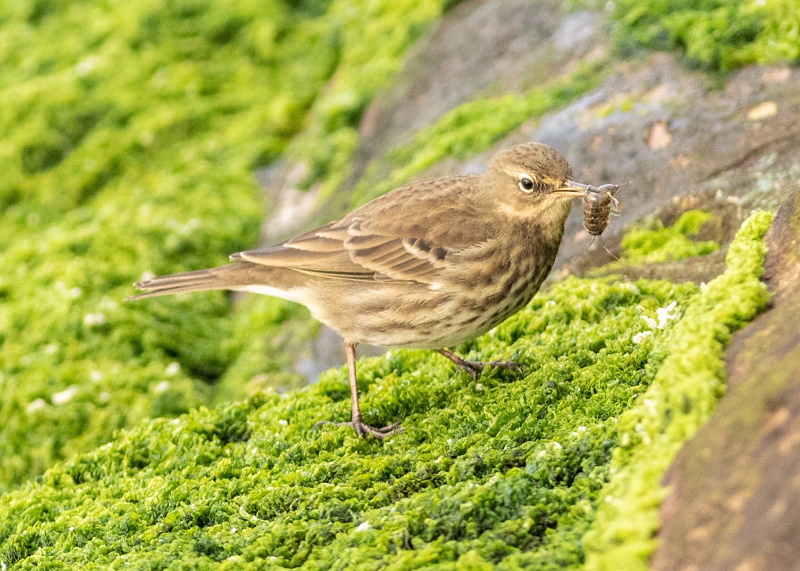
Given the time of year and habitat this is likely to be British race petrosus
References
T.A.Coward and Charles Oldham, The Birds of
Cheshire, published by Sherratt and Hughes, Manchester, 1900
J.D.Craggs, Hilbre, The Cheshire Island, Liverpool University Press,
1982, ISBN 0-85323-314-4
Eric Hardy, Birds of the Liverpool Area, Merseyside Naturalists’
Association Handbook, published by T.Buncle & CO. printers of
Arbroath.
J.P.Guest, D.Elphick, J.S.A.Hunter, D.Norman, The Breeding Bird Atlas
of Cheshire and Wirral, Bath Press, Avon ISBN 0 9517301 0 X.
David Norman, Birds in Cheshire and Wirral, Liverpool University Press,
2008, ISBN 978-1-84631-152-9.
John Elliott, Hilbre Bird
Observatory (June 2020).
NOTE: This
article was first published in the Cheshire and Wirral Ornithological
Society Bird News No. 114 (July 2020).
P.S. At least two pairs of Rock Pipits bred successfully on Hilbre in 2020, there may have been a third pair as three males were heard singing a few times.
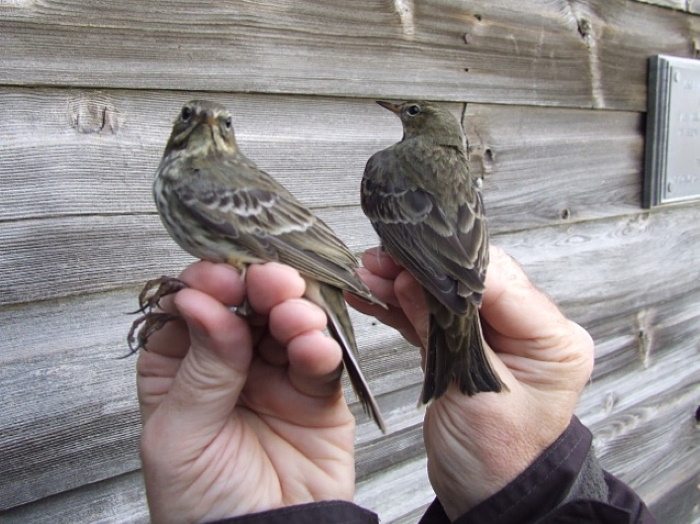
Colour Ring Report
Another good month with 40 colour-ringed birds seen
from 11 species, plus a satellited tagged Hen Harrier. Below is a
summary of the more interesting records.
Hen Harrier
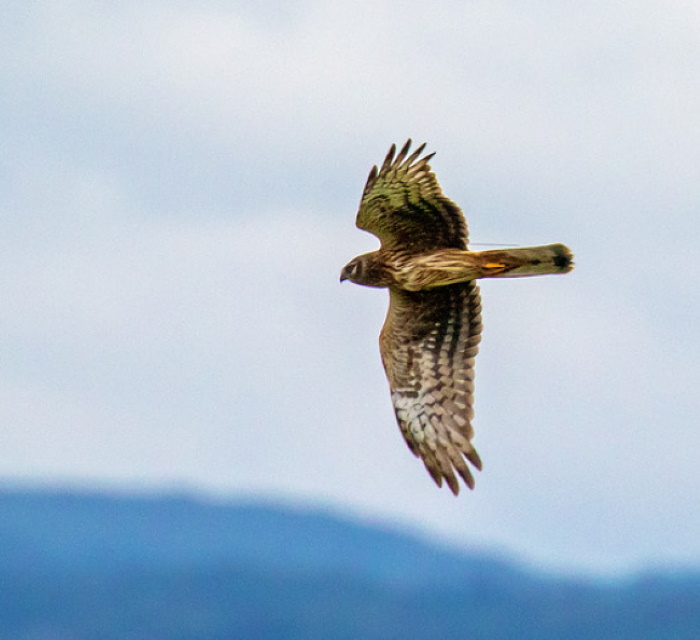
Not a
colour-ringed bird but this satellite tagged Hen Harrier definitely
deserves a place in this report. Jarvis (named after Hen Harrier
enthusiast Jarvis Cocker) was tagged by the RSPB during the 2020
breeding season in Snowdonia. It was tracked arriving on the Dee
estuary on the September 22nd, was photographed on the 23rd but was
observed leaving again the following day and was then recorded just
east of Betws-Y-Coed - not far from where it was hatched. Jarvis's
movements suggest that maybe we see quite a large turnover of Hen
Harriers on the Dee estuary which range over a large area.
Oystercatchers
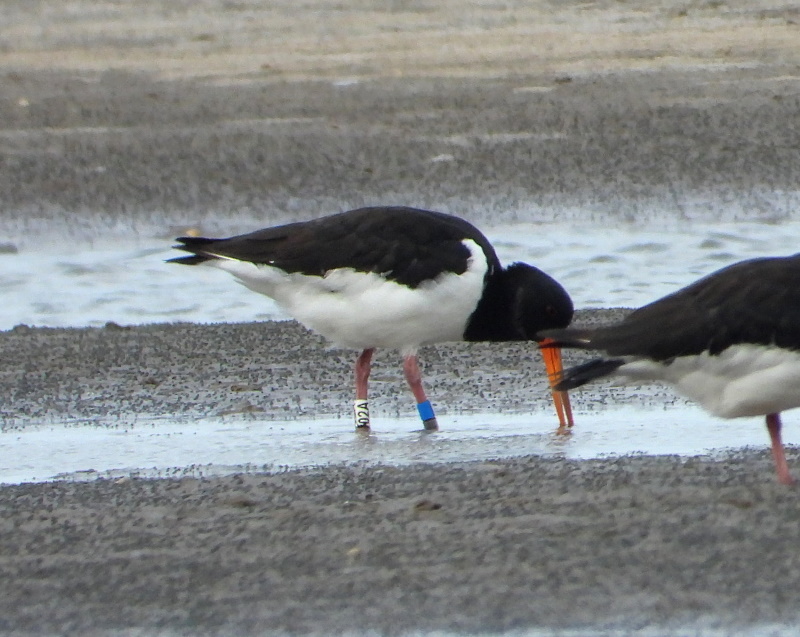
W(02A) - B.
Ringed at Sliddery on the Isle of Arran on 9/3/2018.
Recorded at Meols on 7/9/20 and 16/9/20.
Recorded at Thurstaston on 23/9/20.
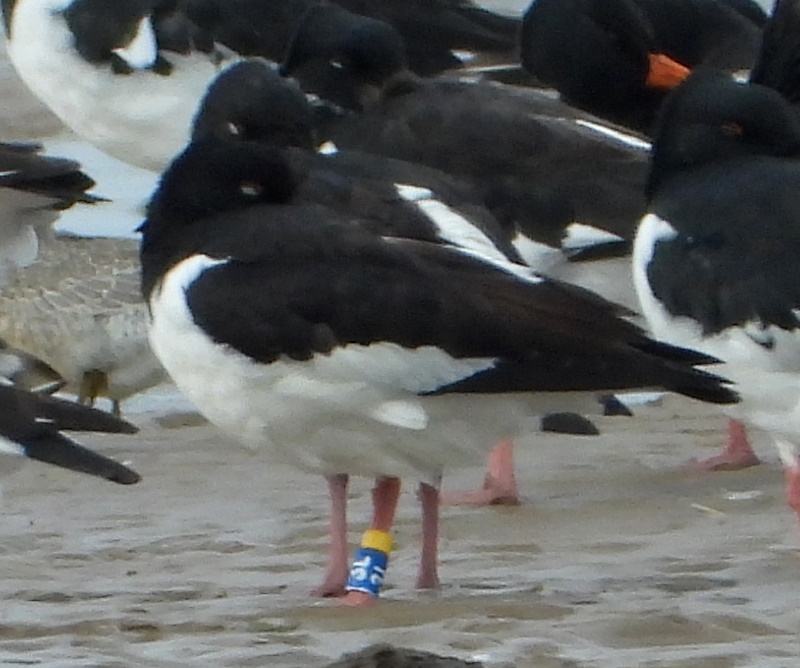
Yellow over B(3L).
Ringed at Dawlish Warren, Exe Estuary, on 4/2/2018.
Since being ringed it has been recorded many times at the ringing site
over each winter. In the winter of 2019/20 it was last seen at Dawlish
Warren on 14/2/20.
Recorded at Hoylake on 4/9/20 but was back again at Dawlish Warren by
10/9/20. I wonder what route it took - directly overland south along
the Welsh borders or the much longer journey around the coast?
This bird was cannon-netted when a total of 190 Oystercatchers were
caught in the first catch at Dawlish Warren since 2004, by the newly
re-formed Devon & Cornwall Wader Ringing Group. It is part of a
study into understanding recent declines in wintering Oystercatchers in
the Exe Estuary SPA. YB(3L) was obviously on passage at Hoylake and we
don't know
where it bred, but the group have had sightings of their ringed
Oystercatchers from various breeding sites including Derbyshire,
Bedfordshire, Co. Durham, Highland Scotland, Islay, Dundalk Bay
(Ireland) and Norway.
If you want to know more about the Exe Oystercatcher project then have
a look at their 2019 Annual Report - http://www.dcwrg.org.uk/images/downloads/Annual Report
2019.pdf where there is an article titled "What are we learning
about Exe Oystercatchers" by R Burrel and J Morten, and another titled
"Ring Reading at Dawlish Warren" by L Collins.
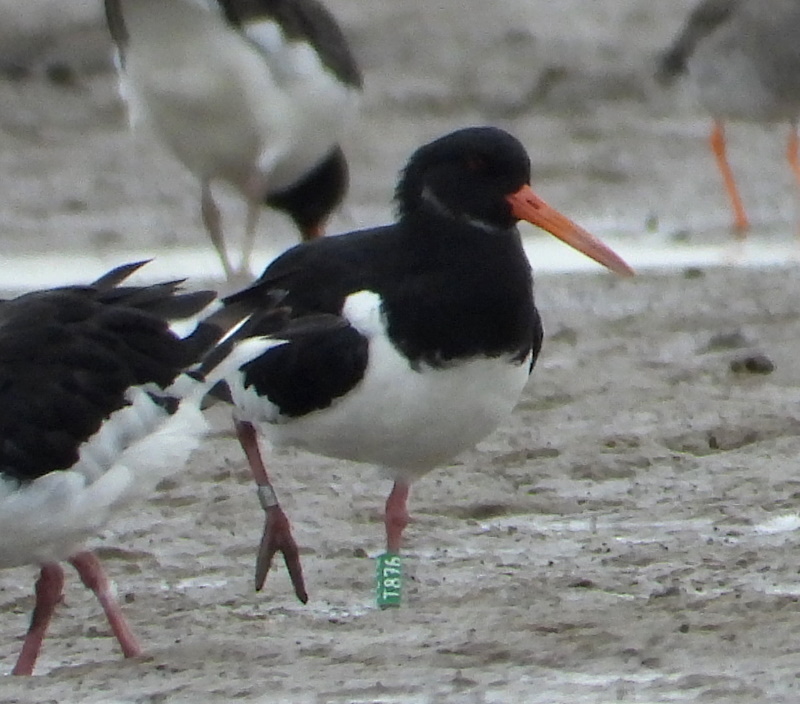
T876 on green ring.
Ringed at Sola in SW Norway on 8/5/2020 as a breeding adult, and
recorded there in mid-July.
Recorded at Seaforth on 5/9/20 and at Meols on 7/9/20.
Ringed Plover
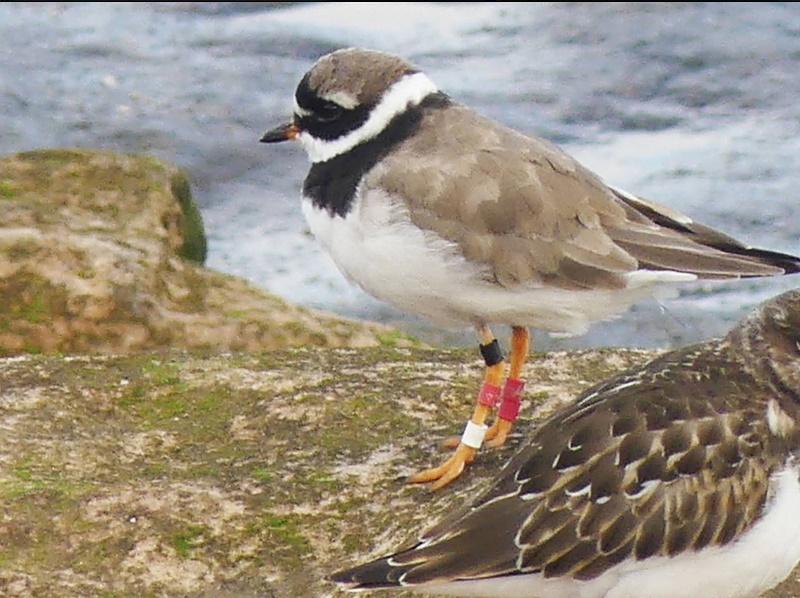
N/RW-RR.
Ringed in th north east corner of the Waddensea on
the German coast on 11/6/16.
It has returned to breed at the ringing site every summer since.
Remarkably, it has been caught another two times; on 5/6/19 when a
missing ring was re-fitted and on 4/6/20 when a GPS tag was fitted. You
can just make out the wire below it's rump in the photo above.
Recorded at Ballycotton, Cork, Ireland on 10/9/19 and at Hilbre on
1/9/20.
Shelduck
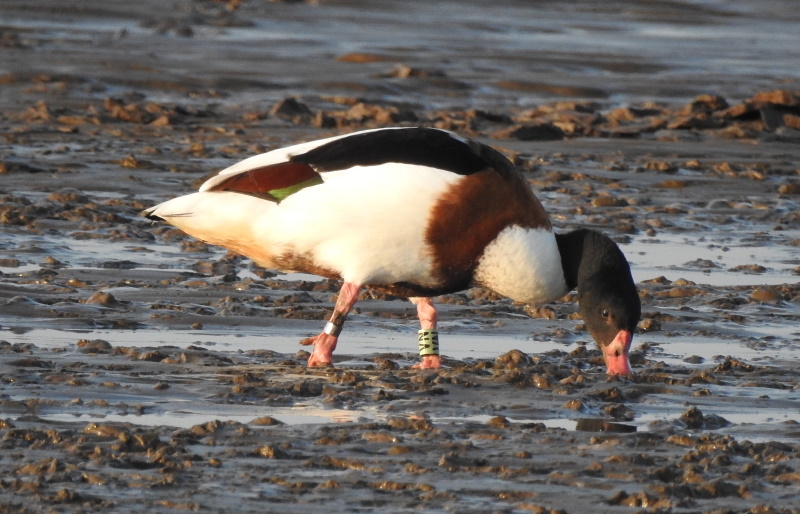
Another eight Lime ringed
Shelduck were recorded at Thurstaston during September. These birds
spend the winter at Martin Mere (where they are ringed) eating the
grain put out for the wild Swans. None of the birds we have recorded
have been seen elsewhere but it seems likely they breed in this
country,
perhaps locally, before moulting in late summer either on the Mersey or
Dee estuaries. They are then seen off Thurstaston in September and
October before returning to Martin Mere.
XD on Black ring.
Ringed at Lower Derwent Valley NNR, just east of York, on 23/3/2011 - a
breeding bird.
Recorded at Thurstaston on 20/9/20.
Common Gull
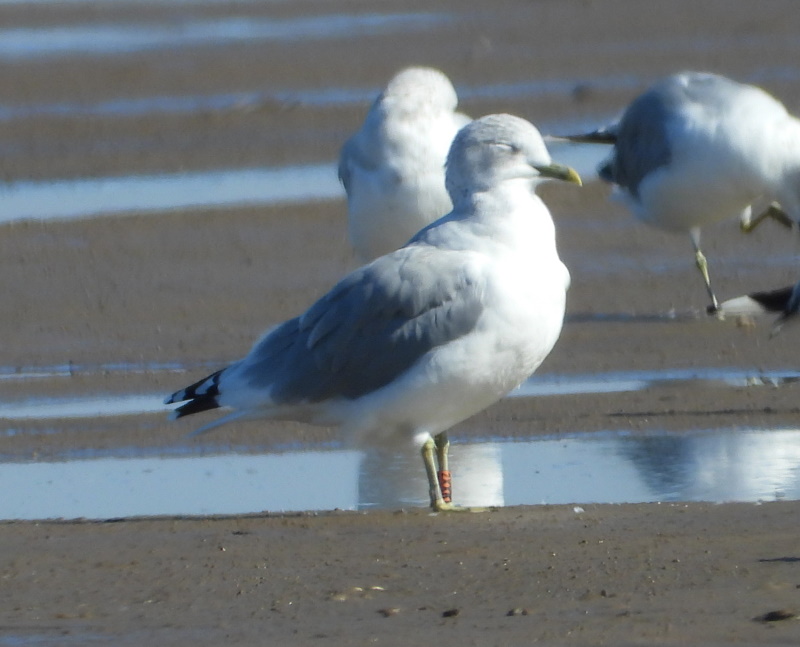
2XXK on an orange ring.
Ringed in Westhill Industrial Estate, Aberdeen, on 5/7/14.
It has been seen at Wallasey in the autumns of 2014, 2015 and 2018.
Recorded at Hoylake on 1/9/20.
Black-headed Gull
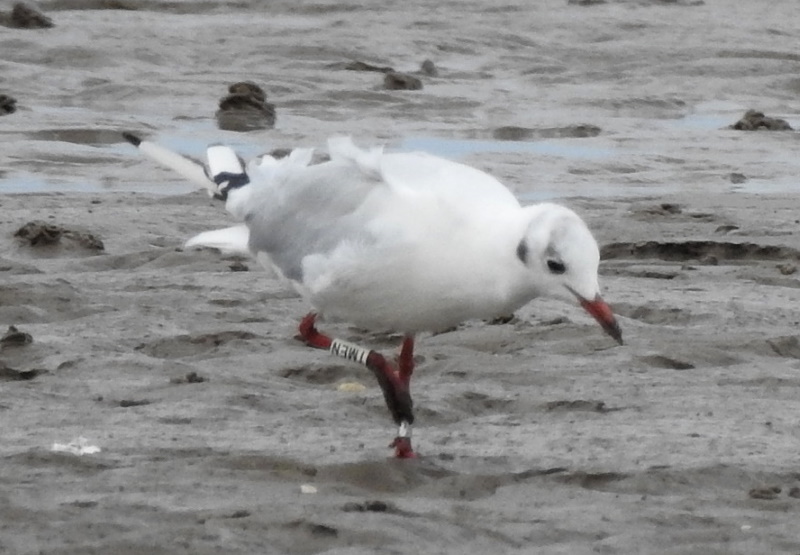
TMEN on White ring.
Ringed in central Poland on 12/4/13.
First recorded at West Kirby on 6/9/2013 it has been seen there every
winter since, often perched on the pontoons on West Kirby Marine Lake.
Over that time it has also been recorded at Hoylake (twice),
Thurstaston
and Greenfield Dock, but never away from the Dee Estuary.
Recorded at West Kirby on 12/8/20 and 2/9/20.
VK13 on
White ring.
Ringed at Frederikshavn on the north-east tip of Denmark on 9/6/11,
Recorded at Leasowe on 16/9/11.
There have been no other records.
Redshanks
Despite being the most
important site in the country for this species we see very few
colour-ringed birds, so it was good to record two over the past few
weeks.
Wflag(AUT)-Y
Ringed in Dundrum Inner Bay, Northern Ireland, on 14/12/19.
Recorded on Heswall Shore on 13/8/20.
O-N(ACH)
Ringed at Ynyslas, Cardigan Bay, on 28/12/19.
Recorded at Hoylake on 26/9/20.
Colour-rings were recorded by Richard Smith, Steve
Hinde, Steve Williams, Colin Jones, Richard Ashford, Tony Ormond, Sue
Haslem, Richard Du Feu, Tim Kinch, Richard Speechley, John Hemmings and
Rob Lewis, Frank Burns photographed the satellited tagged Hen Harrier.
September Bird News
One day of strong north-westerlies early in the month teased us into
thinking we would have some great sea-watching in September but it was
not to be. However, we did see a few Leach's Petrels with five on the
fifth and two on the ninth, but that was it. At least one Sabine's Gull
was spotted on the 5th. A Pomarine Skua was spotted from Hilbre on the
13th but other than that it was a poor month for skuas.
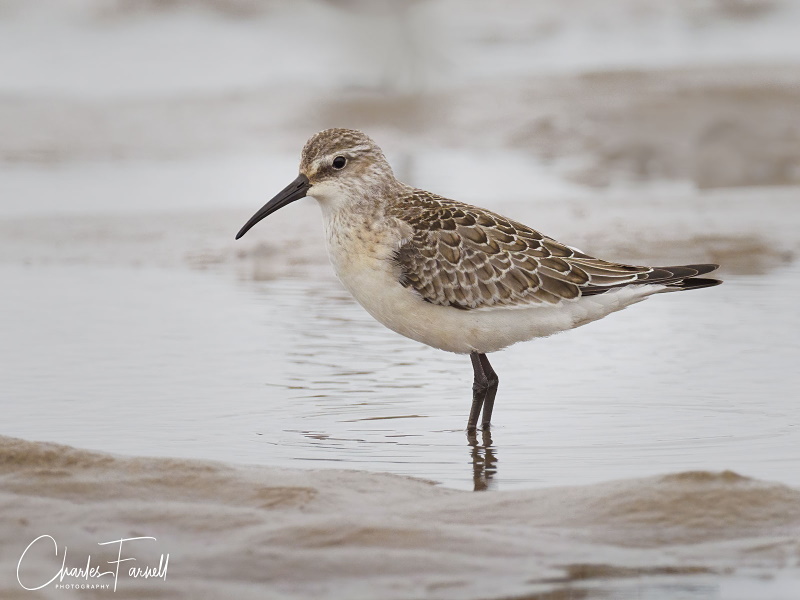
It was certainly a good month for Curlew Sandpipers
with one of the best passages in recent years with numbers peaking in
the first week, including 10 at Burton Mere Wetlands and 16 at Hoylake
on
the 3rd. 10 at Heswall on the 13th was also a good count. Note the
weekly totals shown in the graph are the sum of daily records so any
birds staying more than one day will have been counted more than once.
See 'Curlew
Sandpiper Influx 2016' for
details of Curlew Sandpipers numbers on the Dee Estuary this century.

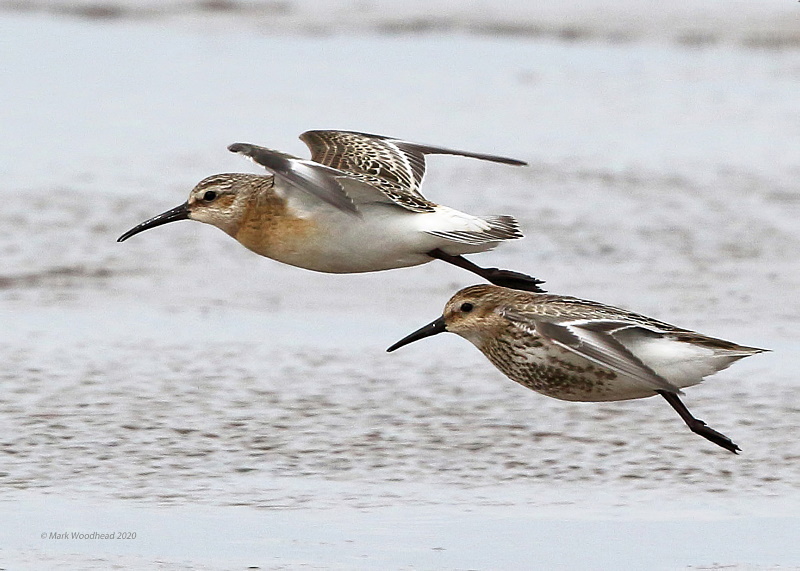
Generally numbers of waders were lower than in August but this very
approachable Golden Plover (below) was a stunning sight at Hoylake
mid-month. A Lesser Yellowlegs at Thurstaston on the 20th was reported
as a 'possible' but having read the description it has to be a
'probable' but unfortunately it wasn't relocated and no photo was
taken. A Pectoral Sandpiper was at Burton Mere Wetlands at the end of
the month, with at least one Spotted Crake still present.

Lots of 'white herons' around with seven Spoonbills still at Parkgate
but it was Egrets which really impressed. Eight Cattle Egret arrived at
Burton Mere Wetlands on the 11th, breaking the previous record of six
in 2016 and 2017, then a week later there were 10! There were lots of
Great Egret sightings but it wasn't until the end of the month when 39
were counted coming in to the roost that we realised just how many
there were - previous max count was 35 in August 2019.
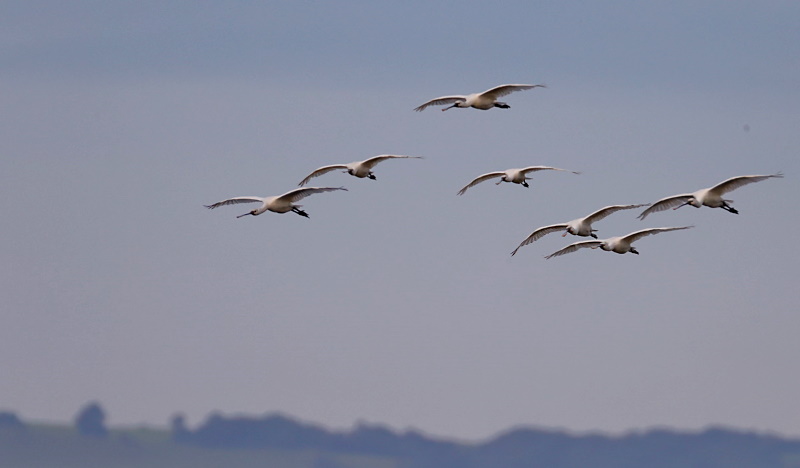
Flocks of Pink-footed Geese were flying into the
estuary all month and the evening flights were spectacular by the last
week with several thousands present - expect even more in October.
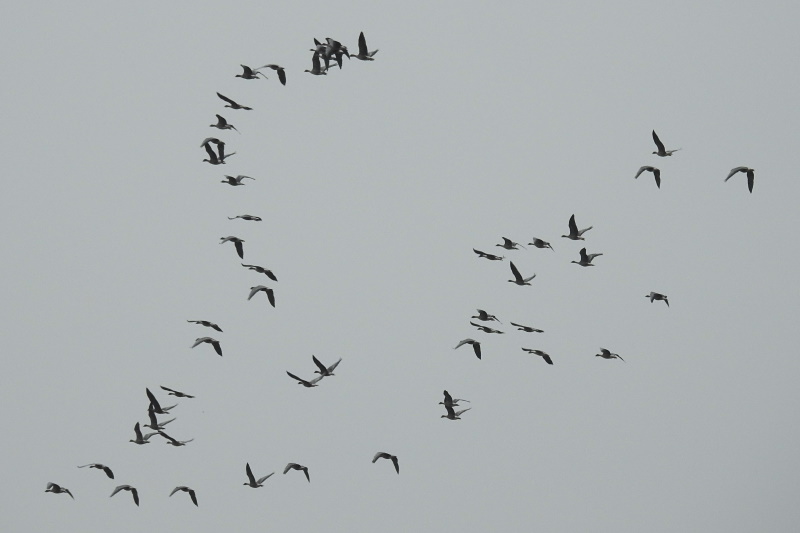
There was plenty of movement of passerines including Wheatears and
Whinchats, and the number of Grey Wagtails flying over suggest they had
a good breeding season.
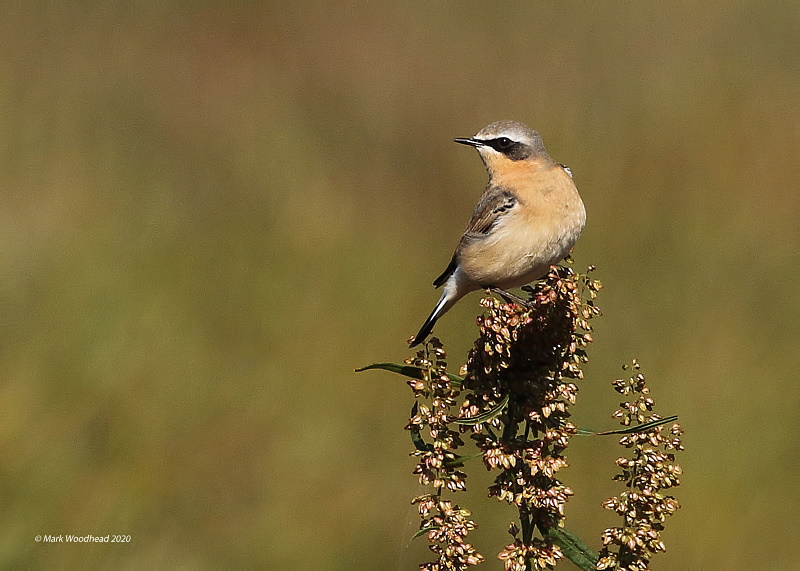
What to expect in October
North-west gales, specially early in the month,
should bring in Leach's Petrels and a selection of skuas, with the
possibility of Sabine's Gulls and Grey Phalaropes. But even flat calm
conditions can be good for sea-watching as we often see huge flocks of
Common Scoters off shore on their way south to winter off Africa, plus
a build up of a few hundred Great Crested Grebes off north Wirral
although numbers seem
to have declined in the past couple of years.
There will be a big influx of Pink-footed Geese with large skeins overhead heading for the marshes, some of these will be on their way to Norfolk but increasing numbers now spend the winter here - last winter's max was an amazing 22100 (in March). October often sees a big influx of both Teal and Pintail with many recorded at both Burton Mere Wetlands and off Oakenholt Marsh. Shelduck numbers will peak in October, the several thousand off Thurstaston make for a spectacular sight. On the marshes Neston Reedbed will be worth checking out in the hour or two before dusk to see the Marsh Harriers fly in to roost, counts could be as high as 20 or more. Great Egrets, Hen Harriers and Short-eared Owls will also be in evidence.
More than anything October is known for migration
with many birds seen on 'Vis Mis' (visible migration). To see Vis Mis
you need to be on site on the coast at dawn preferably during a period
of light to moderate south-east winds and over-cast skies. On a good
day you will see flock after flock of Chaffinches, Starlings, Redwings,
Fieldfares, Siskins and many other species (Brambling, Greenfinch, Wood
Pigeons, various tit species etc) passing overhead heading generally in
a southward direction - see Visible
Migration.
The waders which have roosted further east, on the
Waddensee and the Wash, will arrive en-masse at the end of the month
to spend the winter here - these will be mainly Dunlin, Knot, Grey
Plover and Bar-tailed Godwit.
A bird we really shouldn't be seeing, because it
should be
in south-east Asia, is the Yellow-browed Warbler - but a few do turn up
every year - read The
Yellow-browed Warbler Influx 2016
to find out about this mysterious species. But October is a month we
can expect to see rarities and over the past few years these have
included Chough, Pallid Harrier, Pectoral Sandpiper, Melodious Warbler,
Rosy Starling, Richard's Pipit and Sooty Shearwater.
There are some big high tides due from 16th to the
19th, with a stiff westerly behind them these may well cover the
marshes bringing many of the large numbers of birds described above
close to the shore with spectacular views.
Forthcoming Events
October Highest Spring Tides (Liverpool)
Also see Tides page.
16th October, 11.24hrs (BST), 9.8m.
17th October, 12.06hrs (BST), 10.0m.
18th October, 12.48hrs (BST), 10.1m.
19th October, 13.30hrs (BST), 9.9m.